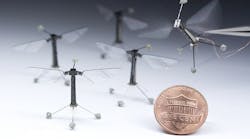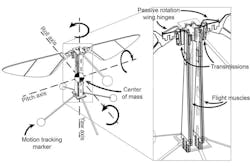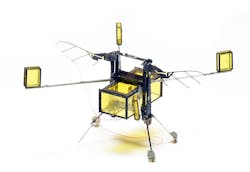Robot developers have longed looked at nature for inspiration. When designing robot mechanisms and movement, animals and human motor functions provide insight on optimal movement that many robotic engineers try to replicate. In 2013, researchers at Harvard’s School of Engineering and Applied Sciences (SEAS) along with the Wyss Institute for Biologically Inspired Engineering at Harvard developed the RoboBee, taking its design inspiration from winged insects. The RoboBee has been a test bed for new robotic mechanical studies as well as new material construction methods. This past month the RoboBee demonstrated a new programming language that taught the robots to not only move like the insect inspiration, but also to think like them.
The History of RoboBee
Back in 2013, after a decade’s worth of work, engineers at Harvard’s SEAS and the Wyss Institute successfully documented the first flight of the RoboBee. The robot’s physical structure is inspired by the biology of a fly, with only a submillimeter-scale anatomy and two wafer-thin wings. The wings are nearly invisible, flapping 120 times per second. The motion-control systems and micro-manufacturing techniques were developed by scratch. The tiny robot uses piezoelectric actuators, which are made out of strips of ceramic that expand and contract when an electric field is applied. Larger robots use electromagnetic motors but at this small scale, the piezoelectric actuators were the only alternative. The carbon-fiber body frame has thin plastic hinges that function as joints. A balanced control system commands the rotational motions with each wing controlled independently in real-time. The control system needs to react quickly to any small—but at this size, powerful—change in airflow, which can have an outsized effect on the flight dynamics.
The RoboBee is an insect inspired robot designed by Harvard’s School of Engineering and Applied Sciences. It is only 2 cm tall and weighs 1/15th of a penny.
The robot was constructed via a pop-up manufacturing technique that was developed by the team in 2011. Laser-cut materials are layered and sandwiched together into a thin and flat plate. The flat materials then pop open like in a child’s pop-up book into its final and complete electromechanical structure. This process replaced what used to be a long and difficult construction method. This allowed the team to rapidly build prototypes for testing.
In 2016 and 2017, the RoboBee acquired new skills. First in 2016, the RoboBee gained the ability to stick to surfaces. It did so by using static electricity. The engineers attached shock-absorbing foam and an electrode patch on top of the machine. The patch dispels a negative charge to the surface, which the robot can attract to. The patch emits a continuous supply of energy to keep the robot from falling off. This advance is useful in helping the robot save energy, as the researchers at SEAS say the robot uses 1,000 times less power when attached to an object rather than flying.
In 2017, a new version of the RoboBee came along that could fly and dive into and out of water. This proved challenging for the team as the size of the robot at only 2 cm and 1/15 the weight of a penny, the immersion into water would destroy the robot’s wings. To solve the issue, the team redesigned the mechanisms, allowing it to transition from water to air. They corrected the flapping speed for aerial and aquatic environments by using a combination of theoretical modeling and experimental data. For aerial travel, 200 to 300 hertz is ideal while 9 to 13 hertz is ideal for water.
The RoboBee can take on water to become buoyant and with an electrolytic plate in the chamber converts the water into oxyhydrogen. This provides the robot with extra buoyancy for the wings to pop out of the water. This way the robot can fly into and an out of the water without damage.
To break the surface tension and escape the water, the machine first collects water into a buoyancy chamber as it swims to the surface. Then an electrolytic plate in the chamber converts the water into oxyhydrogen. This provides the robot with extra buoyancy for the wings to pop out of the water. A sparker then ignites the remaining combustible oxyhydrogen, which provides the boost required to get back into the air.
Advances in RoboBee Programming
The latest advances for RoboBee come in the form of new programming language. A group of engineers at Cornell University has been experimenting with new programming that mimics the way an insect’s brain operates. Silvia Ferrari, professor of mechanical and aerospace engineering and director of the Laboratory for Intelligent Systems and Controls, plans to shrink the robotic computing payload with neuromorphic computer chips.
The computing power required for the RoboBee is extensive. The robot needs to sense changes in gust of winds by using tiny hair-like metal probes imbedded on its wings, adjust its flight accordingly, and plan its path from flight to landing. Traditional computer chips process combinations of 1s and 0s as binary code, neuromorphic chips process spikes of electrical current that fire in complex combinations, just like neurons in a brain. Ferrari’s lab is working on a new class of “event-based” sensing and control algorithms that mimic neural activity. The chips require less power than traditional processors and when paired with the new programming language, allow the robotic engineers to pack more computational information in the same payload.
Ferrari’s lab teamed up with Harvard’s RoboBee to test the new chips. The robot has all the necessary vision, optical flow, and motion sensors needed to provide an adequate test bed. One of the major drawbacks of RoboBee is that it has remained a tethered device. The SEAS team at Harvard has been working to sever that tether with new power sources. The algorithms developed by Ferrari and the Cornell lab will help make RoboBee more autonomous and adaptable to complex environments. (Check out the video from Cornell.)
To help fine-tune the programming and speed up development of the event-based algorithms, Taylor Clawson, a doctoral student in Ferrari’s lab, created a virtual simulator. The physics-based simulator models the RoboBee and subjugates the model with instantaneous aerodynamic forces that it would face during each wing stroke. This way the simulator can accurately model RoboBee’s motions during flights through complex environments.
Ferrari’s lab plans to install into RoboBee new micro devices such as a camera, expanded antennae for tactile feedback, contact sensors on the feet, and air-flow sensors.
“We’re using RoboBee as a benchmark robot because it’s so challenging, but we think other robots that are already untethered would greatly benefit from this development because they have the same issues in terms of power,” says Ferrari.


